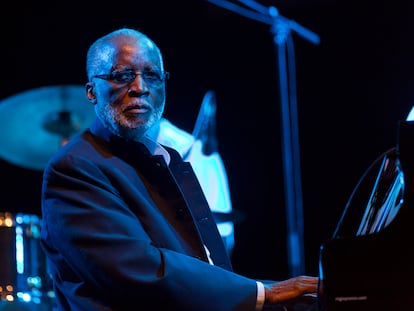Alejandro González Iñárritu: ‘Depicting your dead son is... liberating. It happened 25 years ago, and I was carrying that fragility around’
With ‘Bardo, False Chronicle of a Handful of Truths,’ the Mexican director of ‘Babel’ and ‘Amores perros’, has once again divided critics and the public

Film director Alejandro González Iñárritu recalls that the Spanish village of La Torre de Esteban Hambrán had no more than 60 houses in 1982. He and his friend Jaime San Bernardi, two Mexican kids, arrived there after boarding a cargo ship and crossing the Atlantic; after they got there, they ended up picking grapes in town, an hour away from Madrid. It was the second time González Iñárritu had made the journey by boat. “I had no other way to travel because I didn’t have a penny when I was 19,” he recalls now, sitting in a suite at the Mandarin Ritz hotel in Madrid. Things have clearly changed a lot since then.
On the first boat trip, in 1980 – after running away from home with an older woman and being caught by her father, who severed the relationship – González Iñárritu visited the United States, Barcelona and Sicily. On the second trip, he had $1,000 in his pocket, a gift from his father, Héctor González Gama (a banker who went bankrupt and reinvented himself selling fruit), and ended up in La Torre de Esteban Hambrán, a town that today has 1,700 residents. “San Bernardi and I got up at 4am to wait for the tractors, and at 5.30am Don Julián, accompanied by his son, picked us up and asked us if we had ever picked grapes before.” The Mexicans lied and said they had. “I told him that I had done it in France, because I knew that the vines [in Spain] are lower, and in France they are higher. They explained the process to me as if I were already experienced, gave us some blades and we spent three weeks sleeping in the wine cellar with a barrel of oil and potatoes. Jaime and I will never forget the kidney pain. You bend down 700 times, get up, carry the baskets; next to us, there were some gypsies singing [and] tirelessly harvesting like it was nothing and sharing their cheese with us,” he says with a nostalgic smile. He bursts out laughing: “In the only bar there, I’ll never forget it, I laughed at Jaime’s jokes, and the movement caused [bad] back spasms. It was the first time I tried a carajillo [a coffee-based cocktail], after the bartender recommended it, and when I drank it, the warmth relieved my pain.”
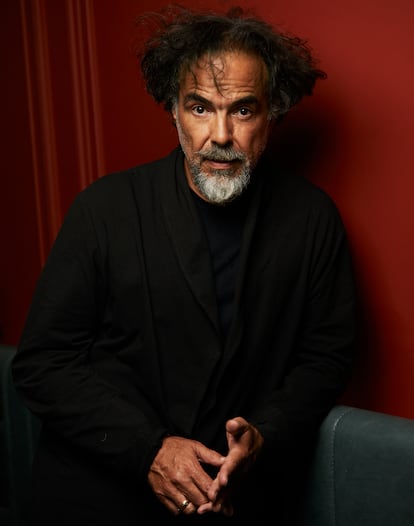
He also remembers another anecdote from those six months in Spain. This one occurred at Piper’s nightclub in Torremolinos. “We had no money, we slept on the beach for three days, and some friends we had made on the train were working as waitresses at that place. So, they introduced us to the manager, and he said: ‘Get into the pool.’ Inside, there were some Black men and a buff blond man and we also got into the pool to dance. After two hours, they kicked us out for being terrible dancers. But we used the money [we earned there] to go to Madrid. It was a ridiculous exchange. I laugh when I remember it… and at the same time I like that ambition of doing anything, even if it was out of necessity: from harvesting grapes to dancing and sleeping several nights on the Retiro [Park] benches. At 19 years old, you have incredible strength, you don’t even need to rest, you think you can fix everything...”
The director still keeps a souvenir from that trip. “The following year, my brother-in-law visited Don Julián, who sent us a bottle of wine from the grapes we’d picked. In 2000, after screening Amores perros in San Sebastian, I took my parents to La Torre de Esteban Hambrán. Don Julián was no longer there [here, González Iñárritu’s gaze fades for a moment]. I wanted to thank him for the bottle of wine. I haven’t opened it yet, nor am I going to.”
Each story Alejandro González Iñárritu tells further cements his legendary status. As the John Ford cliché says, “When the legend becomes fact, print the legend.” And there are many to print: A YouTube video shows the filmmaker with a pendulum, invoking the spirit of French director Jean-Luc Godard. People who were on his set recall that he brought in a shaman; they remember the brutal hours and hours of filming, which accumulated over weeks, months, in search of the perfect filmic experience to the point that he burned out his crew and his actors rebelled. Javier Bardem’s back hasn’t been the same since he filmed Biutiful (2010). Others whisper about González Iñárritu’s religious beliefs. The director is nicknamed El Negro [the black one]; contrary to popular belief, the sobriquet does not come from the color of his clothes but rather from the fact that González Iñárritu is a fan of the late Chilean soccer star Roberto Williams “Negro” Hodge. Old acquaintances speak of Guillermo del Toro’s wise hand in cutting, polishing, and editing Amores perros; they say the feat was accomplished in just one weekend of uninterrupted work and it resulted in González Iñárritu’s first feature film, his calling card to the world of cinema.
For all of that, González Iñárritu still only looks forward. He likes to talk about history, about the centuries-old culture that nurtured him, but not about his own past. “I live in cycles, and when something no longer excites me, I get out. When I find myself repeating things, I want to make a change. Centuries ago, those stages of life didn’t happen because we died earlier [laughs]. From the radio, I went to advertising, and from there to cinema. The good thing about cinema is that it is a high-risk creation; there are no recipes. And that always excites me.” From there, he also takes on other works, such as his immersive virtual reality project Flesh and Sand, which confronted the viewer with the brutality that undocumented Mexican migrants crossing the border into the United States face on a daily basis. Nevertheless, he declares that “the cycle that began in 2000 is now ending with Bardo. I feel content to close this chapter, which has already [been] explored and learned, and I did it the way I wanted to do it.” Bardo, False Chronicle of a Handful of Truths was one of Netflix’s major productions for this awards season. It duplicated Alfonso Cuarón’s Roma challenge in which a prestigious Mexican director delves into his life’s memories. But since its premiere at the Venice Film Festival, Bardo has polarized critics and the press. Now available for streaming, the film is still in the Oscars race (Mexico selected it as the country’s submission for best foreign film), and Iñárritu is waiting patiently: “I took a beating for Biutiful, and now it’s my best film. This kind of cinema needs time. It’s already there, you have to let it do its thing. The audience will find the film. Who is that audience? I don’t know. The filmmaker picks up a pitcher of water and fills a glass. Art is that water, and the glass [is] the viewer. It is made for the person who receives it, [it is] poured over him and it takes shape.”
As he has moved from one cycle to another, González Iñárritu himself has changed. Upon his return from his adventures on the cargo ship, he entered the Universidad Iberoamericana in Mexico City to study communications. In 1985, he began working at the radio station WFM, and two years later he dropped out of school to dedicate himself completely to radio. He went on to head WFM and make it the most popular radio station in his hometown. “I like music more; I know more about it than movies. Now, I remember that time with great satisfaction, but I don’t pine for it,” he says.
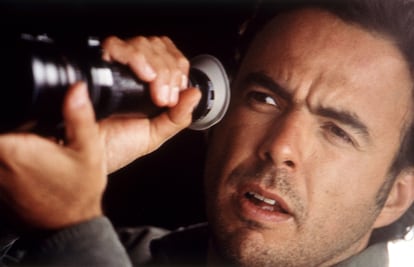
In the 1990s, after composing soundtracks for half a dozen films, González Iñárritu started over again. The images he’d captured over the thousands of hours of films he saw at the Cineteca Nacional [National Film Archives] came pouring out of him, as if they had been boiling in his soul. He founded Z Films and started directing commercials and short films. In Los Angeles, he studied Theater Direction with the Polish-born Mexican director Ludwik Margules, a legend of his craft. González Iñárritu even directed episodes of television shows. And then he began yet another cycle.
González Iñárritu teamed up with Guillermo Arriaga, the screenwriter who wrote the filmmaker’s first three films (and with whom he had a public falling out in 2006). By then, González Iñárritu had already met director Alfonso Cuarón, when the latter was preparing to direct Great Expectations in 1998; González Iñárritu met Del Toro soon thereafter. Since then, the three directors have been an inseparable trio. Eventually the films and Oscars followed: in 2006, all three attended the Academy Awards as nominees: Del Toro for Pan’s Labyrinth, Cuarón for Children of Men and González Iñárritu for Babel. By this time, González had already moved to Los Angeles. “We left because the country couldn’t offer us what we wanted: Guillermo, Alfonso, El Chivo [cinematographer Emmanuel Lubezki] ... Add to that the violence and impunity that existed and exists in my country. In 2000, being a filmmaker was almost impossible. Amores perros was a miracle; today, all kids want to direct. But I haven’t cut the cord,” he says.
That’s why he has lived as an immigrant in California for 21 years. “Throughout my career, in different films, I have observed a phenomenon close to me, immigration, from the outside. I live in a city where I am a migrant – certainly [one] in a privileged situation – but I share the streets with other migrants from different [socioeconomic] classes. In Bardo, I address the subject from my own experience, discussing something that is very difficult to understand, to express, for those who have not experienced it, and that those of us who are displaced [do] understand. I do it without any certainties [by] creating the film from [a place of] uneasiness that lacks answers. I show the feeling that I know I share with millions of people, in a story that has taken me five years to put in order.”
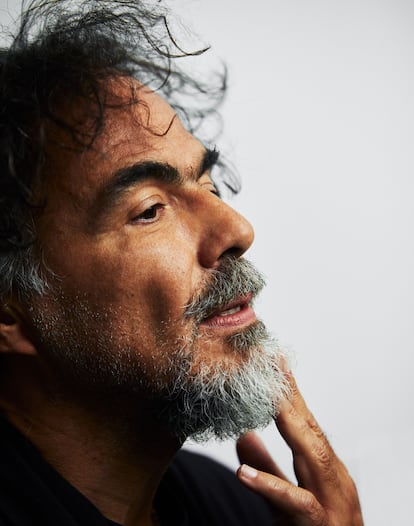
The filmmaker’s voice modulates his speech and captivates the listener. It’s easy to understand why so many Hollywood stars long to work with the director. He recalls the difficult moments in his life that he has brought up in Bardo, such as the loss of his son, as well as more charming ones, such as his relationship with his father. “Depicting your dead son is... liberating. It happened 25 years ago, and I was carrying that fragility around [with me]. In life, you’re left with a crack. But, as Leonard Cohen says, that’s how the light gets through. And that’s how I approached that pain because that way I could see it with more lightness and acceptance.” For González Iñárritu, Bardo enters the realm of confession: “I gave myself over completely to this film; there is nothing to hide or be ashamed of. I open my wounds, my pain, my heart; that’s why I don’t accept certain criticisms. In short, being 59 years old, being this age has few advantages, but one is being able to observe and talk about what happened without going to therapy. This is not a selfie, it is a self, and I appreciate reading novels from this genre because it is an act of generosity.” Without taking a breath, he goes on to note, “That generosity is an act of courage; if you make a film, make it your own; the rest is craftsmanship. Those painful experiences, like the loss of a child, are difficult to understand for those who have not suffered something similar. If you haven’t faced these intangible acts for which there are no words or reason, how do you tell them? There are no words for a father who has lost his son. In any case, on screen I also speak of the loss of a country, the loss of narrative, the loss of memory...”
Return to Mexico City
In Bardo, False Chronicle of a Handful of Truths, the main character, Silverio, is a successful Mexican documentary filmmaker who returns to Mexico City from California with his family to receive a prestigious award. During his stay, he reckons with criticism from those who remained in Mexico, the love of his friends and the contradictions between his work and his life. It is impossible to escape the sense that Silverio, played by Daniel Giménez Cacho, serves as Iñárritu’s alter ego, especially because the actor wears a toupee that makes him look like the director. “Nooo, he’s better looking and thinner,” González Iñárritu replies, raising his hands in a gesture of innocence. “Yes, he is an alter ego, of course, but from there I explore beyond myself. I never intended for [him] to physically resemble [me].” He also rejects the notion of parallels between Silverio’s former friend Luis – a journalist who stayed in Mexico City to produce a successful television program, who rebukes him for fleeing the country – and Guillermo Arriaga. “I would never make a film in such a reductionist way. For me, the dispute between Luis and [Silverio] is about how two antagonistic views define the world. The existential crisis that Silverio is experiencing is [the same as] mine: it pains me to see the world told in tweets, the digital lynching of few words and quick triggers; the triumph of quick prejudices in response to very complex problems [on a platform] in which I do not participate, because I don’t have social media. Silverio understands that the world is slipping through his fingers. It is the crisis of fiction. As a journalist, what is truth, who constructs it and with what agenda? Notice that, in the end, the film itself suffers from the same thing it talks about. We are constantly miscommunicating; there is an anguish in the uncertainty about what is true.”
Before addressing the attacks on the film, González Iñárritu further clarifies his vision of journalism: “I care about understanding what is happening today, and that is why I am interested in journalism. Luis reproaches Silverio for moving away from Mexico and leaving everyone else behind to suffer, but his program is called Suppose, and supposition only leads to bad journalism. The main character seeks the truth, and he moves on from documentaries to fiction, because he understands that in the end everything is fiction. He finds more truth there: fiction requires honesty.” Silverio is just like Alejandro.
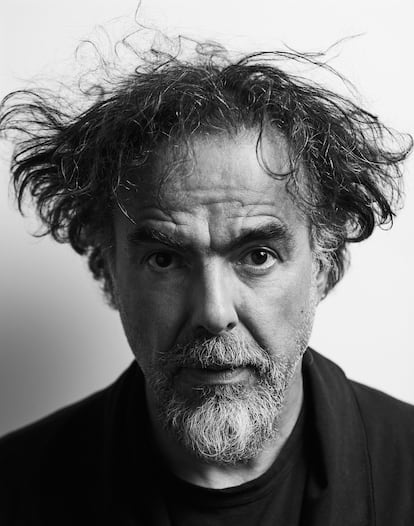
The director says that many critics have misunderstood Bardo, starting with its title. In Buddhist culture, the word “bardo” means an intermediate state or a state of transition (during shooting, the film’s working title was Limbo). “It doesn’t mean minstrel. Please. I didn’t start from there, but from a state of uncertainty. The character and I share [the idea] that memory has no truth but [rather] emotional conviction. The rest of the themes, such as the loss of a son, the onset of adolescence, the conquest of a mestizo country, Mexico’s invasion by multinationals, everything is mine. And the film will be uncomfortable for those who want a narrative to use. I’m sorry. It’s different in nature, and you can see it from there; you can’t judge it from the other side.” He doesn’t sound hurt. “Bardo is basically a dream, a sensory experience, and to ask for logic from a dream is to betray it. I have created freely, and you have to experience it from [a place of] discomfort. There will be those who don’t understand it.” Who won’t understand it? “I find Iain McGilchrist’s book The Master and His Emissary to be crucial; it explains how we operate with the right or left hemisphere of the brain, the difference between the two sides, and how we need both. The right side is the creative one; the left side is for reasoning.” Thus, he stresses, we understand wars, social confrontations, intellectual and artistic love and hate, and respect for Bardo or the cutthroat reception of a film that ends a cycle.
González Iñárritu extrapolates his jab to include the cinematographic references mentioned in the film’s initial reviews, which seek similarities with Federico Fellini’s 8 ½. Western perspectives don’t understand him; they are far removed from the culture that nourished him. González Iñárritu cites Latin American authors as influences, especially Argentine Jorge Luis Borges and Mexican Octavio Paz. “[Bardo] is a very Mexican film. It seems important to me to understand the sources of this imaginary, which are the centuries-old Mexican and general Latin American cultures, which I am familiar with in structure and background. Our imaginary, which is very cool, is displayed with glorious maximalism [and] can be seen in the muralists’ art, in our food and in our music. And that’s what Bardo is about… that and the literary authors that I grew up with. This film has much more of [Spanish director Luis] Buñuel, [Chilean-French director Alejandro] Jodorowsky and [Mexican Juan] Rulfo. To reduce it to an emulation of other world filmmakers, whom I have enjoyed... look, no.” He highlights the film’s music as an example of cultural estrangement: “I knew when I started [Bardo] that brass would be featured on a soundtrack created by a band from Oaxaca, with out-of-tune sounds that sound as much like a funeral as a wedding, with [sounds of] nostalgic joy and longing. Or that it would bring out José José a cappella, a reference that will escape the English-speaking world.”
For González Iñárritu, the conversation about this clash between different cultures serves as a dig: “Today, when someone shares something in the world, the view is usually homogenizing or against it. The global media limit the conversation, and that’s how everything gets screwed up. Think of a soup. Someone says there is a hair in the soup, and [then] we only talk about the hair; we forget about the soup’s virtues. And we don’t even know if that hair exists, just that someone said that it was in there. It’s like the text read in 2005 by David Foster Wallace at Keyton University: ‘Two fish are swimming together when they meet an older fish going in the opposite direction. He greets them and says, ‘Good morning, boys, how’s the water?’ The two fish keep on swimming until after a while one turns to the other and asks, ‘What the hell is the water?’ Anyway, it’s all a mirage, cacophonies of truths.”
The interview ends. The filmmaker explains that his native and adopted countries are similar in their current vilification of culture. “The prelude to fascism is contempt for and attacks on culture, which are spewed on social media. I can take a beating, fine, but for a young person who is building and sharing a vision, these attacks are terrible.” Later on, at the photo shoot, González Iñárritu has time to give one last quote. “Indifference,” he observes, “is the worst. The polarization that Bardo has caused shows me that, deep down, there’s something to my cinema.”
Sign up for our weekly newsletter to get more English-language news coverage from EL PAÍS USA Edition
Tu suscripción se está usando en otro dispositivo
¿Quieres añadir otro usuario a tu suscripción?
Si continúas leyendo en este dispositivo, no se podrá leer en el otro.
FlechaTu suscripción se está usando en otro dispositivo y solo puedes acceder a EL PAÍS desde un dispositivo a la vez.
Si quieres compartir tu cuenta, cambia tu suscripción a la modalidad Premium, así podrás añadir otro usuario. Cada uno accederá con su propia cuenta de email, lo que os permitirá personalizar vuestra experiencia en EL PAÍS.
¿Tienes una suscripción de empresa? Accede aquí para contratar más cuentas.
En el caso de no saber quién está usando tu cuenta, te recomendamos cambiar tu contraseña aquí.
Si decides continuar compartiendo tu cuenta, este mensaje se mostrará en tu dispositivo y en el de la otra persona que está usando tu cuenta de forma indefinida, afectando a tu experiencia de lectura. Puedes consultar aquí los términos y condiciones de la suscripción digital.
More information
Archived In
Últimas noticias
Alain Aspect, Nobel laureate in physics: ‘Einstein was so smart that he would have had to recognize quantum entanglement’
Imelda Castro, the woman who wants to rule the cartel battleground of Sinaloa
The new victims of the Republican war on Obamacare: Millions hit by soaring health insurance premiums
A country divided on migrant rights: Some US states expand protections while others restrict them
Most viewed
- David King, chemist: ‘There are scientists studying how to cool the planet; nobody should stop these experiments from happening’
- Reinhard Genzel, Nobel laureate in physics: ‘One-minute videos will never give you the truth’
- Oona Chaplin: ‘I told James Cameron that I was living in a treehouse and starting a permaculture project with a friend’
- Sinaloa Cartel war is taking its toll on Los Chapitos
- Mexico completes its trade shift with the entry into force of tariffs on China and countries without trade agreements


